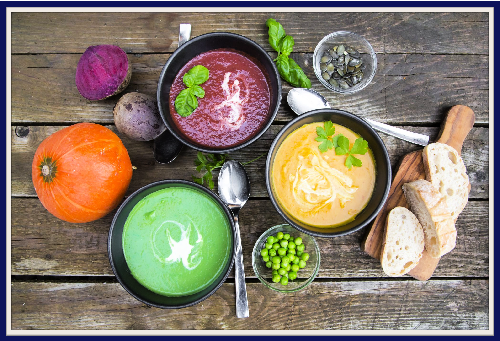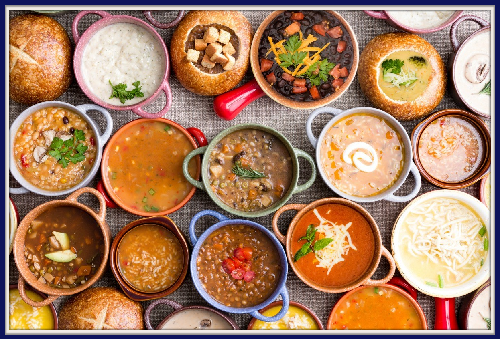
Is it a soup, a stew, a bisque or a chowder? And what is the difference between them? After a little research I realized that there are specific reasons for each name, mainly regional cultural and/or the type of cooking vessel.
So let’s check out a few “definitions” or descriptions that I wish I’d had years ago!
- BISQUE – A French style cream base soup whose main characteristic is a smooth and velvety texture that uses seafood as the protein. This dish is simmered SLOWLY over a low heat which results in the tender meat and rich broth.
- BOUILLABAISSE – A Mediterranean based fisherman stew. Traditionally it is made with a mixture of garlic, tomatoes, saffron, fennel, fish and shellfish.
- BORSCHT – A Russian style stew whose main ingredient is beets. Traditionally it also contains tomatoes, cabbage and many times chunks of meat.
- CASSEROLE – a kind of stew that is cooked slowly in the oven in a “casserole”, a large, deep dish. The casserole dish is typically a dish used both for cooking the food in and serving it in also. Casseroles are of global origin and use. Here, in America, the casserole typically has three components; a meat or protein component, a vegetable and a starch, usually a potato or rice and often there is a cheesy or crunchy topping.
- CHOWDER – Chowder is French in origin and refers to “chaudiere”, a type of “cauldron” used to cook for large gatherings. Many times chowders are made from household staples. Early settlers used ingredients like salt pork, locally caught fish, bread or biscuits. Centuries later potatoes replaced breads or biscuits and milk or cream was added to create rich flavors and thickening of the sauce.
- ETOUFFEE – A spicy Cajun braising process to cook proteins, usually a single meat, in a small amount of liquid making a thick stew with a spicy sauce or gravy. The meats are stuffed or smothered with aromatic vegetables and herbs, covered and SLOWLY simmered until the vegetables flavor has become one with the meat. Cooking this way ensures a flavorful, moist dish that is usually an entree versus a side dish.
- GAZPACHO – A pureed mixture of raw summer vegetables including tomatoes, cucumbers and onions. Classic versions are thickened with breads and include some form of peppers. This is also served cold most often. Gazpacho is considered Spanish, but originated in Greek or Roman times and was brought to Spain the the 1500’s.
- GUMBO – the word gumbo iteself is derived from the African congo word Quingombo for okra, one of the main ingredients used to thicken gumbo. Ground sassafras root or file’ powder is another common thickener. variety of meats served WITH rice unlike Jambalaya that rice is IN the dish – RICE IS THE COMMON COMPONENT – it is just the way it is used in the dish is different – Rice is a VEHICLE for gumbo, but an integral COMPONENT of Jambalaya. Gumbo has a variety of meats/proteins (a fish, poultry, sausage for example) whereas Jambalaya uses a single meat, usually a fish of some sort.
- JAMBALAYA – A pilaf style main dish with a rice like a Paella (probably its early ancestor), but with a Creole Cajun, New Orleans style flavor influence. Traditionally Jambalaya is made with a combination of pork, chicken, shrimp and a variety of herbs and spices.
- MINESTRONE – An Italian vegetable bean soup made with combinations of pasta, cheese, pesto and primarily FRESH seasonal produce.
- MULLIGATAWNY – An Indian soup that almost always contains a chicken stock with curried meat or seafood that is smothered in a coconut milk or cream and lentils, carrots or apples.
- PAELLA – A Spanish dish whose name primarily refers to the style of pan used that is broad and shallow. Traditionally this was made with rice, chicken, rabbit, beans and sometimes snails. Nowadays the “traditional” ingredients have varied to include fish, shellfish, vegetables, pork and sausage.
- POSOLE – A hearty Latin stew that is a blend of chicken stock, chicken or pork, chile peppers, vegetables and hominy. This stew is usually served on special occasions or days of feasting. By many this is considered the gringo version of Menudo that uses a less appetizing (to gringos) cut of meat, the cow stomach.
- POTAGE – is a French soup made with a coarse thick cream and primarily vegetables. It translates into “special of the day”, but NOT the blue plate special as it is traditionally made with the freshest of seasonal ingredients.
- POT PIE – Pot pies have been around for centuries with quite a history from being called Sea Pies made aboard ships or from Roman times with live birds that flew out of the pies to eventually becoming a comfort food traditional in America. Pot pies to me are one of the BEST comfort foods. There is nothing better than a flaky crust filled with a mixture of chunks of chicken, peas and carrots in a rich gravy like soup. A great cousin to the pot pie is a Shepherd’s pie that has a topping of mashed potatoes or a cornbread, biscuit topping.
- SEVICHE – A FRESH, raw seafood in a marinade made from tomatoes or lemon juice. The acids in the tomato or lemon juice “cook” the seafood, removing the raw taste and leaving you a flavorful dish.
- STEW – Stews are found all around the world by many names, each dealing with regional cultural ingredients. Some of those examples are Hungarian Goulash, Italian or French Ragout and American Brunswick stew from Virginia or Burgoo from Kentucky. Stews are made up of the browning of small pieces of meat in a hot fat, poultry pieces or chunks of fish that then simmers with vegetables, herbs and spices in enough liquid to cover everything in a closed vessel of some sort (dutch oven or stock pot). A stew can be simmered over low heat on the stove top or baked in the oven also at low heat and when left alone allows the flavors to blend naturally while also tenderizing tougher cuts of meat. The sauce that develops as the dish cooks may be thickened by pureeing the vegetables or by incorporating flour or egg yolks.
- VICHYSSOISE – A classic French soup that is made with potatoes, leeks, herbs, chicken stock and a heavy cream. This is typically pureed and served chilled with a FRESH chive garnish. Shhh… don’t tell anyone, but I like it warm and hate it cold, but love the flavor mixture.



[…] SOUP TUTORIAL […]
I’ve never really thought about it but very interesting Tamy!
LOL this is where my mind goes when I have so much time on my hands and start looking through recipe scraps. Some I found were called soups, some bisques etc… but they all looked liked soups so I did some due diligence to get my answer LOL 😀 You know how my mind works, every time I found a “new” word the research went a bit deeper until I was into tutorial mode.